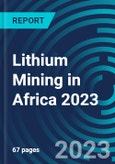Challenges
Due to inadequate rail, road and electricity supply infrastructure in many parts of Africa, a large deposit is needed in these areas to make it economical to mine, especially if mines are far from ports. Most African countries have banned lithium ore exports, forcing companies to construct concentrate plants, which adds to project costs.Introduction
Increasing demand for lithium due to the energy transition and an expected supply deficit in the near future are seeing battery and battery electric vehicle manufacturers wanting to secure supply and invest in African mines and projects. Africa’s lithium output is growing rapidly, and dozens of companies are actively exploring the continent for lithium. Many African countries contain lithium deposits and the continent is generally underexplored. Despite inadequate rail, road and electricity supply infrastructure in many parts, and the requirement in most countries to process ore before lithium can be exported, Africa is expected to produce nearly a quarter of global output by 2030, up from less than 1% in 2021.Opportunities
Africa has many mines that historically produced other minerals and could be reopened relatively cheaply to produce lithium. Demand for lithium for battery manufacturing is growing significantly because of rechargeable lithium batteries’ use in battery electric vehicles, electric tools, portable electronic devices and off-grid energy storage systems; much of it driven by the energy transition.Outlook
Global lithium supply is expected to catch up to demand in 2023. Prices are expected to rise when demand exceeds supply. Demand will be driven by growth in electric vehicle sales. Africa is expected to account for nearly a quarter of global supply by 2030, with Zimbabwe contributing almost 40%.Report coverage
This report on lithium mining in Africa includes comprehensive information on the size and state of the industry, projects underway, notable players, corporate actions and regulations, as well as information on the competitive environment, outlook and the international industry. There are profiles of 12 companies including Chinese subsidiary Bikita Minerals, which mines in Zimbabwe, Australian company AVZ Minerals, operating in the DRC, and locally-owned company Zimbabwe Lithium Company, involved in the Kamativi tailings project.Trends
African countries are increasingly banning lithium ore exports, forcing mining companies to process the ore into higher value concentrate before export. This means governments will get more economic benefit from their lithium resources. Many mines that historically produced other minerals are being reopened to produce lithium.Table of Contents
1. INTRODUCTION2. CONTINENT INFORMATION5. INTERNATIONAL8. INDUSTRY SUMMARY9. OUTLOOK10. INDUSTRY ASSOCIATIONS
3. DESCRIPTION OF THE INDUSTRY
4. LOCAL
6. INFLUENCING FACTORS
7. COMPETITIVE ENVIRONMENT
11. REFERENCES
APPENdix
COMPANY PROFILES
Methodology

LOADING...








